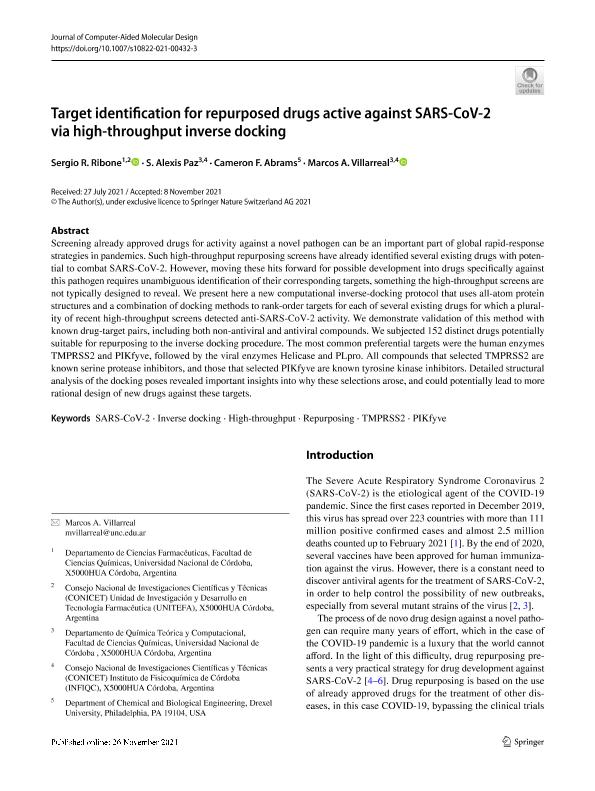Mostrar el registro sencillo del ítem
dc.contributor.author
Ribone, Sergio Roman

dc.contributor.author
Paz, Sergio Alexis

dc.contributor.author
Abrams, Cameron F.
dc.contributor.author
Villarreal, Marcos Ariel

dc.date.available
2022-01-11T17:23:09Z
dc.date.issued
2021-11
dc.identifier.citation
Ribone, Sergio Roman; Paz, Sergio Alexis; Abrams, Cameron F.; Villarreal, Marcos Ariel; Target identification for repurposed drugs active against SARS-CoV-2 via high-throughput inverse docking; Springer; Journal of Computer-Aided Molecular Design; 2021; 11-2021; 1-13
dc.identifier.issn
0920-654X
dc.identifier.uri
http://hdl.handle.net/11336/149938
dc.description.abstract
Screening already approved drugs for activity against a novel pathogen can be an important part of global rapid-response strategies in pandemics. Such high-throughput repurposing screens have already identifed several existing drugs with potential to combat SARS-CoV-2. However, moving these hits forward for possible development into drugs specifcally against this pathogen requires unambiguous identifcation of their corresponding targets, something the high-throughput screens are not typically designed to reveal. We present here a new computational inverse-docking protocol that uses all-atom protein structures and a combination of docking methods to rank-order targets for each of several existing drugs for which a plurality of recent high-throughput screens detected anti-SARS-CoV-2 activity. We demonstrate validation of this method with known drug-target pairs, including both non-antiviral and antiviral compounds. We subjected 152 distinct drugs potentially suitable for repurposing to the inverse docking procedure. The most common preferential targets were the human enzymes TMPRSS2 and PIKfyve, followed by the viral enzymes Helicase and PLpro. All compounds that selected TMPRSS2 are known serine protease inhibitors, and those that selected PIKfyve are known tyrosine kinase inhibitors. Detailed structural analysis of the docking poses revealed important insights into why these selections arose, and could potentially lead to more rational design of new drugs against these targets.
dc.format
application/pdf
dc.language.iso
eng
dc.publisher
Springer

dc.rights
info:eu-repo/semantics/openAccess
dc.rights.uri
https://creativecommons.org/licenses/by-nc-sa/2.5/ar/
dc.subject
SARS-COV-2
dc.subject
INVERSE DOCKING
dc.subject
HIGH-THROUGHPUT
dc.subject
REPURPOSING
dc.subject
TMPRSS2
dc.subject
PIKfyve
dc.subject
COVID-19
dc.subject.classification
Otras Ciencias Químicas

dc.subject.classification
Ciencias Químicas

dc.subject.classification
CIENCIAS NATURALES Y EXACTAS

dc.title
Target identification for repurposed drugs active against SARS-CoV-2 via high-throughput inverse docking
dc.type
info:eu-repo/semantics/article
dc.type
info:ar-repo/semantics/artículo
dc.type
info:eu-repo/semantics/publishedVersion
dc.date.updated
2022-01-11T14:31:02Z
dc.journal.volume
2021
dc.journal.pagination
1-13
dc.journal.pais
Suiza

dc.description.fil
Fil: Ribone, Sergio Roman. Consejo Nacional de Investigaciones Científicas y Técnicas. Centro Científico Tecnológico Conicet - Córdoba. Unidad de Investigación y Desarrollo en Tecnología Farmacéutica. Universidad Nacional de Córdoba. Facultad de Ciencias Químicas. Unidad de Investigación y Desarrollo en Tecnología Farmacéutica; Argentina
dc.description.fil
Fil: Paz, Sergio Alexis. Universidad Nacional de Córdoba. Facultad de Ciencias Químicas. Departamento de Química Teórica y Computacional; Argentina. Consejo Nacional de Investigaciones Científicas y Técnicas. Centro Científico Tecnológico Conicet - Córdoba. Instituto de Investigaciones en Físico-química de Córdoba. Universidad Nacional de Córdoba. Facultad de Ciencias Químicas. Instituto de Investigaciones en Físico-química de Córdoba; Argentina
dc.description.fil
Fil: Abrams, Cameron F.. Drexel University; Estados Unidos
dc.description.fil
Fil: Villarreal, Marcos Ariel. Universidad Nacional de Córdoba. Facultad de Ciencias Químicas. Departamento de Química Teórica y Computacional; Argentina. Consejo Nacional de Investigaciones Científicas y Técnicas. Centro Científico Tecnológico Conicet - Córdoba. Instituto de Investigaciones en Físico-química de Córdoba. Universidad Nacional de Córdoba. Facultad de Ciencias Químicas. Instituto de Investigaciones en Físico-química de Córdoba; Argentina
dc.journal.title
Journal of Computer-Aided Molecular Design

dc.relation.alternativeid
info:eu-repo/semantics/altIdentifier/url/https://link.springer.com/10.1007/s10822-021-00432-3
dc.relation.alternativeid
info:eu-repo/semantics/altIdentifier/doi/http://dx.doi.org/10.1007/s10822-021-00432-3
Archivos asociados
